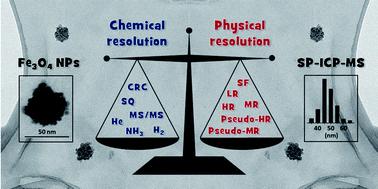当前位置:
X-MOL 学术
›
J. Anal. At. Spectrom.
›
论文详情
Our official English website, www.x-mol.net, welcomes your feedback! (Note: you will need to create a separate account there.)
Characterization of iron oxide nanoparticles by means of single-particle ICP-mass spectrometry (SP-ICP-MS) – chemical versus physical resolution to overcome spectral overlap
Journal of Analytical Atomic Spectrometry ( IF 3.4 ) Pub Date : 2020-07-31 , DOI: 10.1039/d0ja00183j Ana Rua-Ibarz 1, 2, 3, 4, 5 , Eduardo Bolea-Fernandez 1, 2, 3, 4, 5 , Guillermo Pozo 5, 6, 7, 8 , Xochitl Dominguez-Benetton 5, 6, 7, 8 , Frank Vanhaecke 1, 2, 3, 4, 5 , Kristof Tirez 5, 6, 7, 8
Journal of Analytical Atomic Spectrometry ( IF 3.4 ) Pub Date : 2020-07-31 , DOI: 10.1039/d0ja00183j Ana Rua-Ibarz 1, 2, 3, 4, 5 , Eduardo Bolea-Fernandez 1, 2, 3, 4, 5 , Guillermo Pozo 5, 6, 7, 8 , Xochitl Dominguez-Benetton 5, 6, 7, 8 , Frank Vanhaecke 1, 2, 3, 4, 5 , Kristof Tirez 5, 6, 7, 8
Affiliation

|
As a result of their unique physical, chemical and/or biological properties, the use of engineered nanoparticles (ENPs) is growing very rapidly. Iron oxide nanoparticles (IONPs) are of particular interest owing to their magnetic properties, and thus the development of suitable methods for their characterization is essential. Inductively coupled plasma-mass spectrometry (ICP-MS) operated in single-particle (SP) mode provides different types of relevant information, such as size distribution and particle number and mass concentrations. However, the use of SP-ICP-MS becomes less straightforward when the analyte signal is subject to spectral overlap. In the case of IONPs, characterization by means of SP-ICP-MS is hindered by the occurrence of ArO+ polyatomic ions with the same nominal mass-to-charge (m/z) ratio as the most abundant Fe isotope. In this work, different approaches relying on either chemical or physical (mass) resolution, to avoid this spectral interference otherwise jeopardizing accurate results, were assessed. In the case of chemical resolution, the performance of on-mass and mass-shift approaches was evaluated using different types of quadrupole-based ICP-MS instrumentation, including single-quadrupole (SQ) and tandem ICP-MS (ICP-MS/MS) units. Physical resolution was accomplished using a new generation of sector field (SF) ICP-MS instrumentation, capable of dealing with transient signals of extremely short duration (10–100 μs dwell time), even when operated at higher mass resolution (pseudo-resolution mode). Based on the figures-of-merit obtained for the different approaches evaluated, an on-mass approach using NH3 as the reaction gas in SQ-ICP-MS, an on-mass approach using H2 as the collision/reaction gas in ICP-MS/MS and pseudo-medium resolution in SF-ICP-MS were found to be the best-suited approaches for fast interference-free monitoring of the ion signals generated by IONPs in SP mode. While the use of chemical (H2/on-mass) and physical (pseudo-medium) resolutions also provided accurate and precise results for custom-made Fe3O4 (magnetite) NPs of ≈50 nm, the use of NH3 was less successful, as it leads to an extension of the SP pulse profile and a lower signal-to-background ratio. Finally, SF-ICP-MS operated in pseudo-medium resolution mode was used for the characterization of Fe3O4 NPs synthesized electrochemically (batch and continuous operation mode).
中文翻译:

通过单颗粒ICP-质谱(SP-ICP-MS)表征氧化铁纳米颗粒–化学对物理分辨率,克服光谱重叠
由于其独特的物理,化学和/或生物学特性,工程化纳米颗粒(ENP)的使用正在迅速增长。氧化铁纳米颗粒(IONPs)由于其磁性而特别受关注,因此开发合适的表征方法至关重要。以单粒子(SP)模式运行的电感耦合等离子体质谱(ICP-MS)提供了不同类型的相关信息,例如尺寸分布,粒子数量和质量浓度。但是,当分析物信号发生光谱重叠时,SP-ICP-MS的使用变得不那么直接。对于IONP,通过SP-ICP-MS进行表征会受到ArO +具有相同标称质荷比的多原子离子(m / z)比是最丰富的铁同位素 在这项工作中,评估了依靠化学或物理(质量)分辨率的各种方法,以避免这种光谱干扰,否则会损害准确的结果。在化学拆分的情况下,使用不同类型的基于四极杆的ICP-MS仪器(包括单四极杆(SQ)和串联ICP-MS(ICP-MS / MS))对质量和质量转移方法的性能进行了评估。 ) 单位。物理分辨率是使用新一代的扇形场(SF)ICP-MS仪器实现的,即使以更高的质量分辨率(伪分辨率模式)运行,也能够处理持续时间极短(10–100μs驻留时间)的瞬态信号。 )。根据评估的不同方法获得的品质因数,使用NH的质量方法3作为SQ-ICP-MS中的反应气体,采用H 2作为ICP-MS / MS中的碰撞/反应气体和SF-ICP-MS中的假介质分离度的最佳方法是适用于在SP模式下对IONP生成的离子信号进行快速无干扰监视的方法。尽管使用化学(H 2 /质量)和物理(伪介质)分辨率也可为≈50nm的定制Fe 3 O 4(磁铁矿)NP提供准确的结果,但NH 3的使用却是不太成功,因为这会导致SP脉冲分布的扩展和较低的信噪比。最后,使用伪中等分辨率模式下的SF-ICP-MS表征Fe 3O 4 NPs电化学合成(间歇和连续操作模式)。
更新日期:2020-09-02
中文翻译:

通过单颗粒ICP-质谱(SP-ICP-MS)表征氧化铁纳米颗粒–化学对物理分辨率,克服光谱重叠
由于其独特的物理,化学和/或生物学特性,工程化纳米颗粒(ENP)的使用正在迅速增长。氧化铁纳米颗粒(IONPs)由于其磁性而特别受关注,因此开发合适的表征方法至关重要。以单粒子(SP)模式运行的电感耦合等离子体质谱(ICP-MS)提供了不同类型的相关信息,例如尺寸分布,粒子数量和质量浓度。但是,当分析物信号发生光谱重叠时,SP-ICP-MS的使用变得不那么直接。对于IONP,通过SP-ICP-MS进行表征会受到ArO +具有相同标称质荷比的多原子离子(m / z)比是最丰富的铁同位素 在这项工作中,评估了依靠化学或物理(质量)分辨率的各种方法,以避免这种光谱干扰,否则会损害准确的结果。在化学拆分的情况下,使用不同类型的基于四极杆的ICP-MS仪器(包括单四极杆(SQ)和串联ICP-MS(ICP-MS / MS))对质量和质量转移方法的性能进行了评估。 ) 单位。物理分辨率是使用新一代的扇形场(SF)ICP-MS仪器实现的,即使以更高的质量分辨率(伪分辨率模式)运行,也能够处理持续时间极短(10–100μs驻留时间)的瞬态信号。 )。根据评估的不同方法获得的品质因数,使用NH的质量方法3作为SQ-ICP-MS中的反应气体,采用H 2作为ICP-MS / MS中的碰撞/反应气体和SF-ICP-MS中的假介质分离度的最佳方法是适用于在SP模式下对IONP生成的离子信号进行快速无干扰监视的方法。尽管使用化学(H 2 /质量)和物理(伪介质)分辨率也可为≈50nm的定制Fe 3 O 4(磁铁矿)NP提供准确的结果,但NH 3的使用却是不太成功,因为这会导致SP脉冲分布的扩展和较低的信噪比。最后,使用伪中等分辨率模式下的SF-ICP-MS表征Fe 3O 4 NPs电化学合成(间歇和连续操作模式)。



























 京公网安备 11010802027423号
京公网安备 11010802027423号